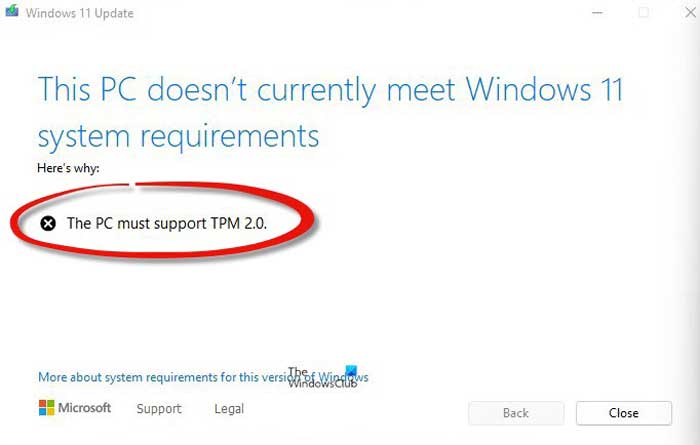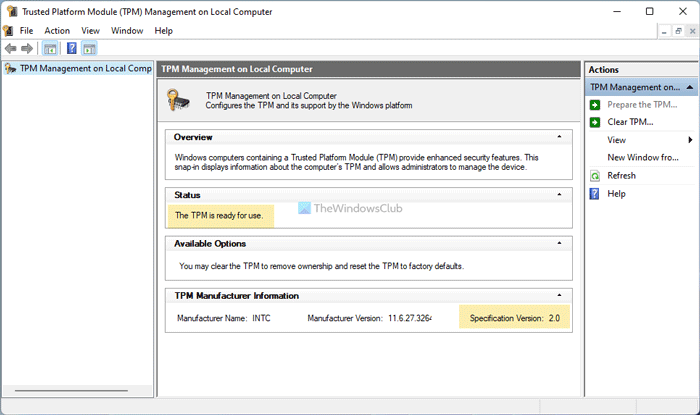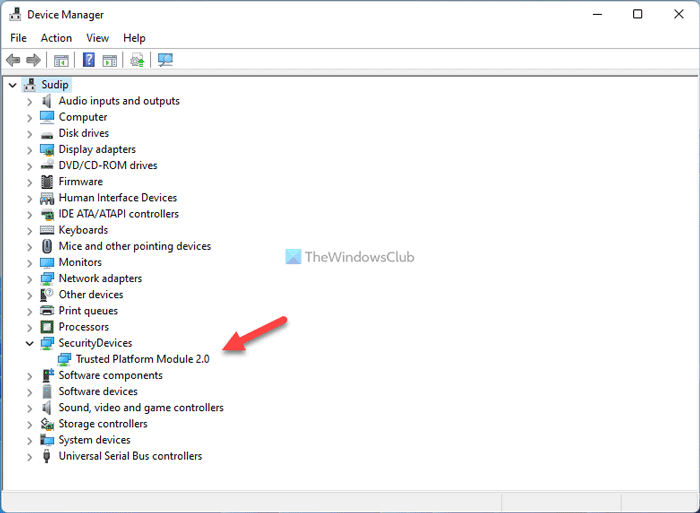If you are getting The PC must support TPM 2.0 error while upgrading to Windows 11, here are a couple of things you need to check to bypass this issue. It is a common problem when your motherboard/chipset doesn’t support TPM 2.0, or you haven’t enabled it.

There are multiple ways to install or upgrade to Windows 11. For example, you can use the Windows Updates method from the Windows 10 Settings panel, create a bootable Windows 11 USB fresh drive for fresh installation, etc. One of the methods is by using the Windows Update Assistant. If you are using that method but getting The PC must support TPM 2.0 error message, this guide will help you to fix that. For your information, you can get the same error when you double-click on the setup.exe file in the Windows 11 ISO.
What is a TPM 2.0 device?
TPM or Trusted Platform Module 2.0 is a dedicated physical security chip that provides security against various modern-day attacks. Although installing a TPM 2.0 device manually is possible, most present days’ motherboards have this module in built. As Windows 11 requires TPM 2.0 to be installed, the it displays this error when you do not have it yet.
The PC must support TPM 2.0
To fix The PC must support TPM 2.0 error, follow these steps:
- Check if you have TPM 2.0
- Enable TPM in BIOS
- Bypass TPM requirement
- Get TPM supported chipset and motherboard
To learn more about these steps, continue reading.
1] Check if you have TPM 2.0
It is probably the most important thing to check before going forward with other steps. If there is an issue with the installer, you might get this error even if the Trusted Platform Module is enabled. There are multiple ways to check if you have TPM 2.0.
Press Win+R to open the Run dialog, type tpm.msc, and hit the Enter button to get started.
A window should appear on your screen mentioning the version and Status as The TPM is ready for use.

However, if you do not have the module, you will be greeted with a Compatible TPM cannot be found message.
The second way to check if you have TPM or not is by using the Device Manager. As it is a dedicated module, it gets added to the Device Manager automatically. To get started, press Win+X and click on the Device Manager option.
Then, expand the SecurityDevices menu and check if Trusted Platform Module 2.0 is visible or not.

If it is visible, you can run the scan again or download the update assistant installer. However, if you have a compatible chipset and motherboard but it is not enabled, you can move on to the next solution.
2] Enable TPM in BIOS
In some cases, TPM is not enabled by default. If so, you need to turn it on manually. Whether you use an ASUS, Gigabyte, MSI, or any other motherboard, you can enable it as long as you have the module. Although it depends on the manufacturer, you need to look for Trusted Computing, Trusted Module, or any other similar option. Also, you might find it inside the Security settings.
After enabling it, restart your computer and follow the aforementioned method to find if TPM 2.0 is visible in the respective places or not.
You will need to enable TPM and Secure Boot on Hyper-V too, if you are installing Windows 11 on a virtual machine.
3] Bypass TPM requirement
It is probably the best way to install Windows 11 when you have unsupported computer hardware. Although Microsoft relaxed a few things to install Windows 11 on unsupported computers, you may still encounter some issues. If so, you can follow this step-by-step tutorial to bypass the TPM requirement to install Windows 11.
4] Get TPM supported chipset and motherboard
It is the last thing you can do to install and use Windows 11 on your home computer. Microsoft has already released a list of supported chipsets and motherboards that have TPM 2.0 support. You can take a look at the list and get a motherboard that has TPM enabled.
TPM 2.0 error when I try to install Windows 11 on a virtual machine
If you are trying to install Windows 11 on a virtual machine, then know this. Windows 11 will not support most Virtual Machines. Said Microsoft,
This build includes a change that aligns the enforcement of the Windows 11 system requirements on Virtual Machines (VMs) to be the same as it is for physical PCs. Previously created VMs running Insider Preview builds may not update to the latest preview builds. In Hyper-V, VMs need to be created as a Generation 2 VM.
Windows 11 Virtual Machines too will now require TPM 2.0 and Secure Boot.
How do I fix TPM 2.0 error?
There are multiple ways to fix TPM 2.0 error while installing Windows 11 on your computer. You need to start by checking if you have TPM 2.0 or not. Following that, you need to enable it from the BIOS. Depending upon the motherboard, you can find the option similar to Trusted Computing.
Does TPM 2.0 require UEFI?
Yes, TPM or Trusted Platform Module requires UEFI or Unified Extensible Firmware Interface. If you do not have the UEFI for your computer, you won’t be able to use this module. In other words, CSM or Legacy forms are not supported by TPM 2.0.
How do I know if TPM 2.0 is enabled?
To know if TPM 2.0 is enabled, you can press Win+R to open the Run dialog, type tpm.msc, and press the Enter button. If it shows The TPM is ready for use and Specific Version: 2.0, you have TPM 2.0. However, if it shows Compatible TPM cannot be found, you do not have the corresponding module.
Read: Fix Alert! TPM device is not detected error on Dell computers.